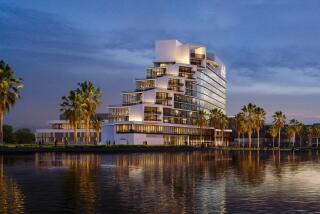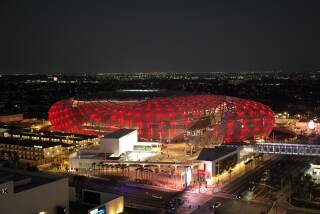Commentary: How SoFi Stadium makes a revolutionary design promise: A place for all to play
- Share via
In less than two weeks, if the NFL moves forward as planned, SoFi Stadium will open in Inglewood after more than five years of design and construction.
Finally, the Rams will no longer have to play in the sun-baked L.A. Coliseum. Finally, the Chargers will no longer have to be squatters in the tiny Dignity Health Sports Park (formerly the StubHub Center and the Home Depot Center). Finally, owner Stan Kroenke will see his dream of a $2 billion (well, make that more than $5 billion now) sports and entertainment park begin to come true.
But here’s the more important news: From a design and urban planning standpoint, SoFi is, potentially, revolutionary.
That’s because, in many ways, this stadium is not really a stadium. It’s not a solid concrete and steel bowl where fans park cars and push their way in and out eight times a year. And it’s not a themed shopping mall and mini amusement park grafted onto a sports facility.
SoFi Stadium is a porous, indoor-outdoor, year-round complex featuring, yes, a 70,000-seat stadium and lots of parking, but also a 2.5-acre public plaza, an adjacent 6,000-seat performance space and a layered landscape filled with hills, trees, places to pause and sit and eat — all connected to a vibrant 25-acre community park surrounding a 5.5-acre lake.
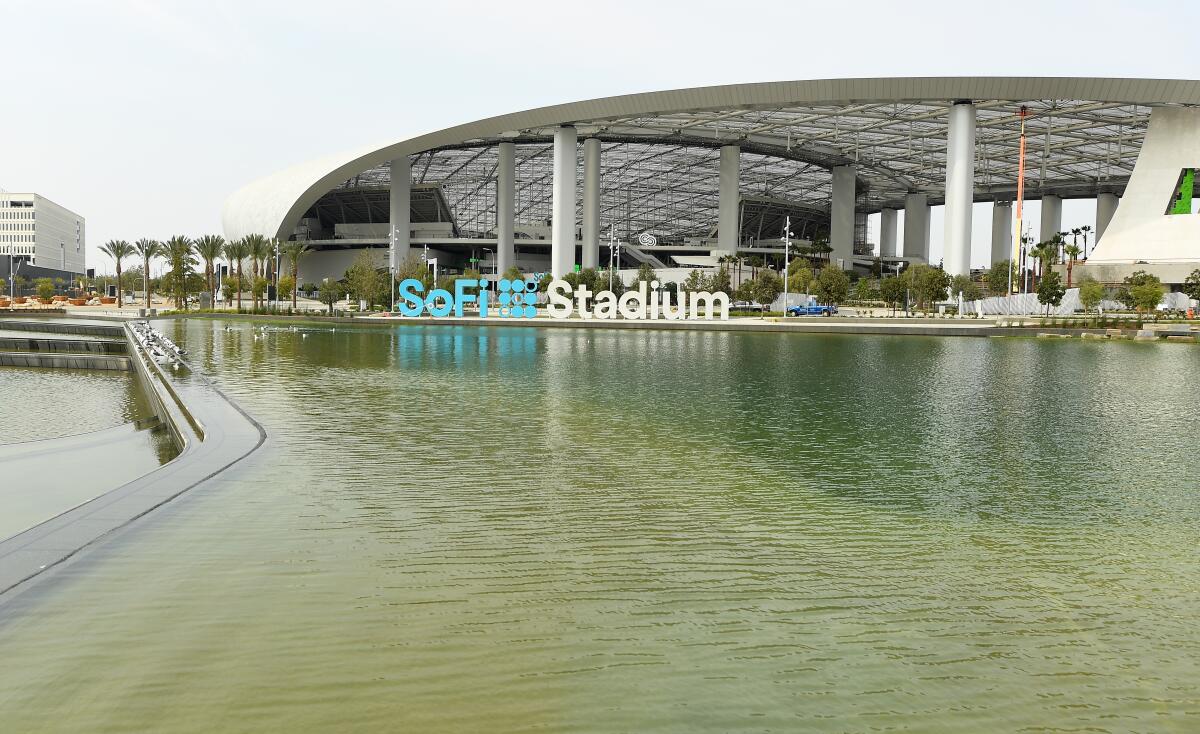
The 300-acre complex, to be called Hollywood Park, is slated to phase in over many years more than 1.5 million square feet of retail, restaurant and office space (including the almost-complete NFL Network headquarters and studios), at least 2,500 townhomes and apartments and a hotel.
The idea of a stadium as the focal point for a mixed-use project is not new. So-called sports-anchored developments are becoming the norm nationwide, from Patriot Place in New England to the Arlington Entertainment District in Texas. But more than any of those developments (including downtown Los Angeles’ L.A. Live), this complex — its stadium’s façade curving like the sweep of the coast — is authentically inspired by, and caters to, its setting.
“We were trying to create an expression of Southern California,” said Lance Evans, principal with HKS Architects. “Something that would resonate with this climate and with this place.”
This is something that only Dodger Stadium — embedded into the earth, obsessed with the future and surrounded by palm trees, the landscapes of Elysian Park and, alas, a heroically scaled parking lot — has managed to accomplish in terms of local sports venues.
Workers have been putting the finishing touches on SoFi despite the risk of COVID-19 infection (more than 50 have tested positive) and two deaths on the site, including one caused by a fall from the roof.
Citing the pandemic, the Rams, Chargers and SoFi jointly announced Aug. 25 that games will be played without fans “until further notice.” Once fans are allowed to come, they will approach a stadium whose field level is embedded 100 feet into the earth, reducing the building’s bulk as seen from the rest of the neighborhood and making a trip inside reminiscent of a trek down bluffs to a beach in, say, Malibu. Along the way they will proceed via a fractured landscape of textured pathways, gardens, patios and food stalls, descending through what the project’s landscape architect, Studio-MLA, calls “canyons” — terraced trails filled with earthen mounds and plants and trees from around California, weaving in and out of the stadium.
“It’s all about how the stadium is part of the landscape and the landscape is part of the stadium,” said Studio-MLA founder Mia Lehrer, who has designed green spaces for Dodger Stadium and for Banc of California Stadium in Exposition Park. She also is imagining the surroundings for the forthcoming Lucas Museum of Narrative Art.
In classic SoCal fashion, the stadium, its edges open to the outdoors along the sides, blurs the line between interior and exterior, inviting visitors, and views, inside. It pulls in ocean breezes through its aerodynamic shape, its permeable flanks, the lifting of its seating bowl above the ground-level concourse and massive (60 feet by 60 feet) adjustable openings in its roof that can slide like sunroofs on cars. These openings can “tune” the wind flow, according to HKS, which designed recent stadiums for the Minnesota Vikings, Indianapolis Colts and Dallas Cowboys.
The roof, which covers and unifies the stadium bowl, plaza and adjacent arena, is clad in ethylene tetrafluoroethylene, or ETFE, a tough, translucent plastic that, thanks to its dotted frit pattern, shades fans from about half of the sun’s heat. (If you’ve roasted at the Coliseum or at Dodger Stadium, you will appreciate that.) The ETFE also will allow concerts, community gatherings, e-sports, the Super Bowl and the Olympics to carry on in the rare case of rain.
One bummer: The roof’s tempering of the sun means that the field had to be made of artificial turf, although such surfaces have progressed light-years since the days of AstroTurf.
For the record:
12:42 p.m. Sept. 2, 2020An earlier version of this article misstated the weight of SoFi’s Oculus screen as 2,000 pounds. It weighs 1,000 tons.
The seating bowl itself is not revolutionary, but its proximity to the field is as close as the NFL will allow — a good thing for fans. A massive, oval-shaped screen hangs from steel rafters, projecting images on both sides, which makes it readable from a wider range of sightlines and seat locations. It weighs more than 1,000 tons and traces the circumference of the field level, making SoFi the new champion of the NFL’s Jumbotron wars.
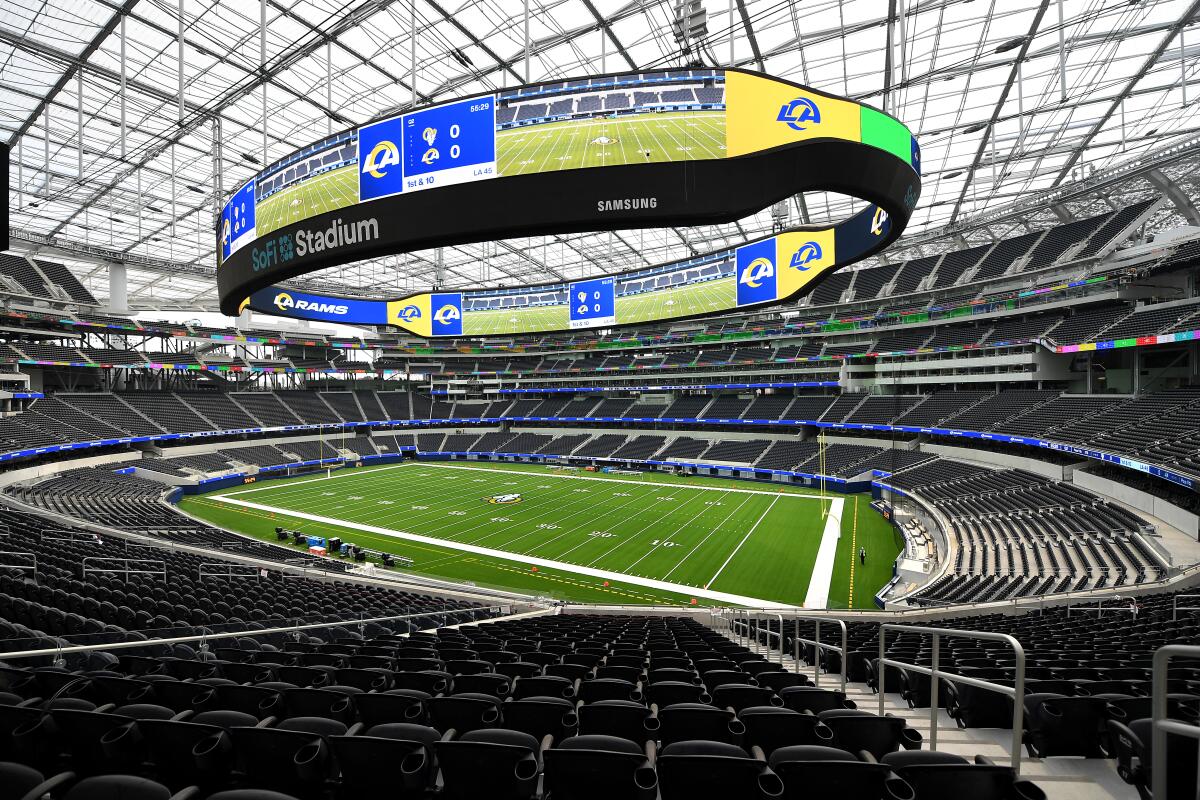
The stadium sits under a major LAX flight path, and as seen from above that roof bears an uncanny resemblance to the Rams former shield-shaped logo. (Attempts to confirm this connection were rebuffed by both the designers and the developers, perhaps to protect the Chargers’ feelings?) But where the roof bends down, meeting the ground at a few distinct points, you can see its lightweight aluminum façade panels, consisting of thousands of unique triangles, perforated with millions of holes to admit breezes and create intricate dappled light patterns.
Connected to the stadium via textured pathways and a grove of palm trees is Lake Park, the other focal point of the development. The park has the potential to be a profound amenity for Inglewood.
An artificial lake — which collects water runoff from around the complex — was inspired by the lake at Hollywood Park Racetrack, which used to stand on the site. It’s surrounded by a mix of flora that’s even more robust than what is along the stadium’s edge, including some plants that are quite exotic. Lehrer calls them Dr. Seuss plants, including the strangely fractured monkey puzzle tree and the jug-shaped bootle tree. All are part of the Mediterranean biome, an effort by Studio-MLA to connect Southern California to similar environments worldwide, including the Mediterranean region, the Cape of Africa and Chile.
Visitors can experience, among other things, long allées of trees edging the water, undulating arroyos, seats built into angled planters, impressive views across the lake to the stadium and a deck projecting over the water.
The park, and much of the stadium’s periphery, will be open to the public every day, not just on game days, making the landscape part of the neighborhood. The complex’s ability to host almost any type of event should help energize the site most of the year. It has the potential to become a real civic place, not just a sports-fueled fan zone. But just how civic is up to Kroenke and his team.
Despite many positive signs, much of the 300-acre site remains a question mark. The landscaping, as fantastic as it seems, is so young it’s hard to tell just how effective it will be. And it’s still unclear how much of the immediate stadium area will remain open when events aren’t taking place. Parking lots dominate the site’s future development areas, and because of the incredibly uncertain economy, there’s no guarantee that all of these elements ever will come. (Nor is it a sure thing that this development, if it does come, will be welcoming.)
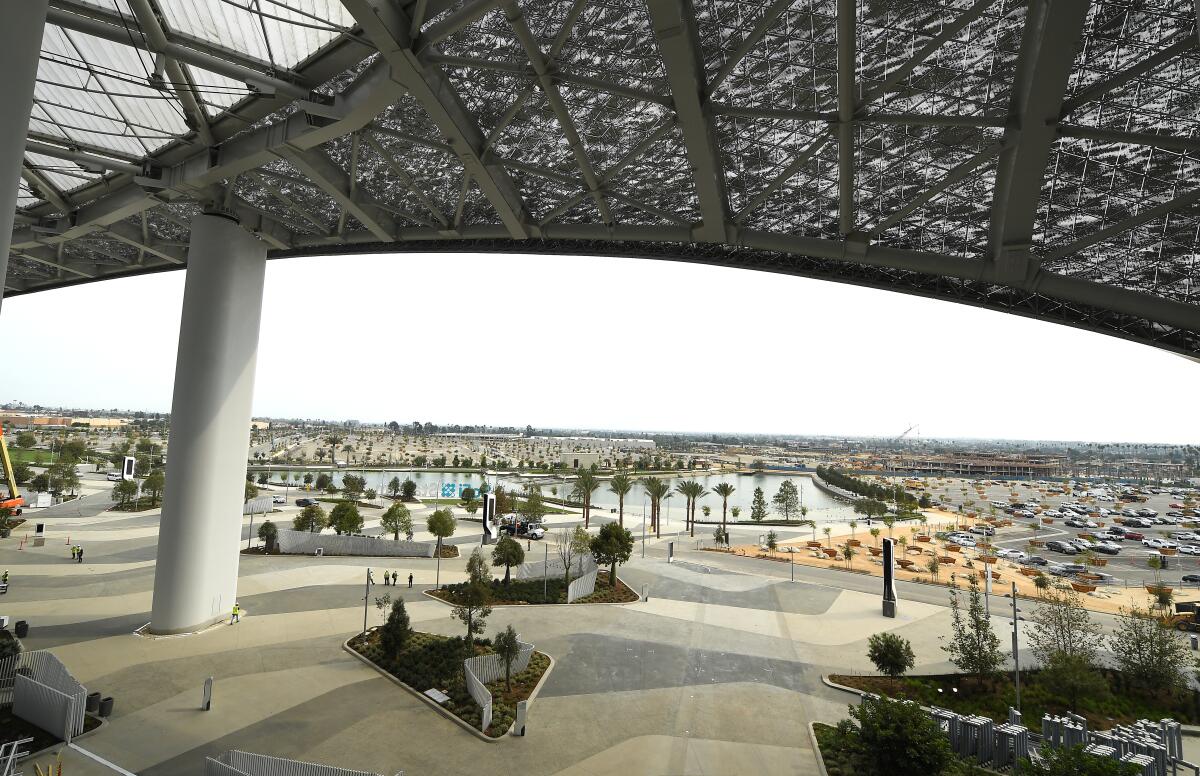
Football is a sure thing, and the Super Bowl and the College Football National Championship seem likely, as do the Olympics. But many other events — like those catering to the local community — are a long way from being programmed. How will the place interact with the neighborhood around it, including the Forum to the north and a planned complex for the Clippers to the south? Also: Can a stadium with 260 luxury suites and 13,000 premium suites really be considered civic?
For now, public transit connections to the stadium are problematic. A so-called transportation hub along the site’s west edge, amassing buses from nearby neighborhoods and the Metro Crenshaw Line’s Downtown Inglewood light rail station (delayed until late 2021), is just a parking lot. (The Inglewood Transit Connector, an elevated tram running from the Metro station to SoFi, the Forum and other destinations, is still just a plan.)
Thanks to COVID-19, we probably won’t know for more than a year how the whole complex performs. Not until a game day with actual fans, actual concessions, actual crowd noise, actual traffic.
So, like everything else in our current state of suspended animation, we’ll have to wait and see whether SoFi Stadium and Hollywood Park are a success, for fans, for the region, and for the concept that a stadium can become a true community asset. We’ll have to keep a close eye. What’s been achieved so far is impressive, but it’s just the beginning.
More to Read
The biggest entertainment stories
Get our big stories about Hollywood, film, television, music, arts, culture and more right in your inbox as soon as they publish.
You may occasionally receive promotional content from the Los Angeles Times.

